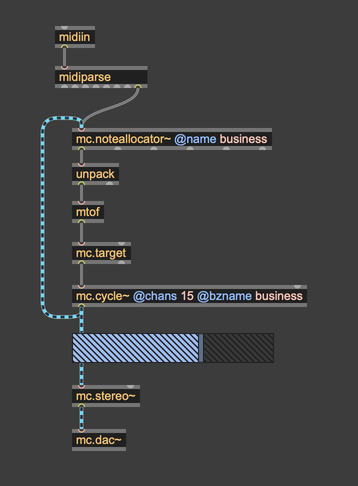MC Managed Polyphony
The MC Wrapper can manage polyphony without the use of the poly~ object. You can assign Max messages or MIDI events to specific MC channels and turn off processing for unused channels.
The Basis for Polyphony
Using the poly~ object, a polyphonic synth has a defined voice count. poly~ will load a separate patcher for each voice, which generates or processes sound independently from the other patchers. By contrast, with MC-based polyphony, there is a single patcher with MC wrapper objects set to a number of channels equal to the total voice count. For example, in this simple example, the mc.cycle~, mc.*~, and mc.gain~ objects have 12 channels. If you could control these objects independently, you could hear 12 independent voices.
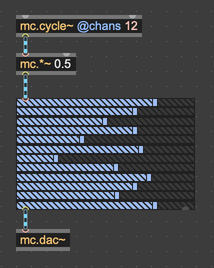
A good polyphony management system has three main benefits:
-
To the maximum extent possible given the fixed resources allocated to your synth, new notes will not cut off already-playing notes.
-
Voices allocated are spready cyclically to all channels, permitting pleasing panning or mixing effects based on channel number. For example you could spread channels across a stereo space knowing that on average, notes played will tend to fill the space.
-
A polyphony management system can help keep track of which voices are actually playing and manage DSP resources by shutting off process for voices not producing sound.
As with the Max poly~ object, the MC polyphony system provides all three benefits. DSP resource management is more involved with MC polyphony than with poly~; we'll cover that in the final section below.
MC Polyphony using MIDI Notes
The mc.noteallocator~ object accepts MIDI messages and directs messages to a specific target voice based on its internal voice allocation mechanism. Voices can be allocated either on the basis of MIDI note-on and note-off messages, or, more typically, by connecting a multichannel audio signal to the left inlet of mc.noteallocator~. In that case, when a note-off for an allocated voice has been received and the corresponding audio signal in the multichannel input goes to zero, mc.noteallocator~ marks that channel as available to be allocated when future MIDI note-on messages are received.
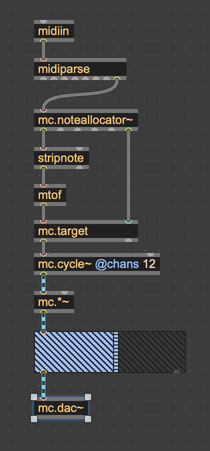
To specify a maximum number of voice numbers for allocation, supply a value for the @voices attribute. By default the @voices attribute has a value of zero, which means that if a multichannel audio signal is connected to the left inlet of mc.noteallocator~, it will use the number of channels in the incoming audio signal. If no audio signal is connected, mc.noteallocator~ will use a default of 15 voices (mc.voiceallocator~ works similarly but defaults to 16 voices).
MC Polyphony using Max Messages
If you prefer to allocate and control MC channels using Max messages instead of MIDI notes, you can use the more general mc.voiceallocator~ object. Here is an example driven by a metro object that allocates and releases voices using mc.voiceallocator~.
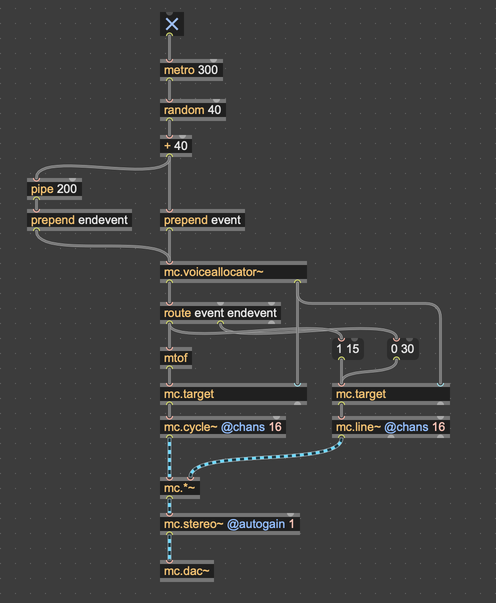
The mc.voiceallocator~ object accepts the endevent and release messages to free an allocated voice, so if you want to write your own audio analysis algorithm to detect when a "note" has finished playing, that algorithm could trigger these messages.
Managing DSP Resources
MC polyphony manages DSP resources by turning off channels of processing within each object using the MC wrapper. To enable/disable this behavior you need to use the @usebusymap attribute for each MC object.
A busy map is maintained by mc.noteallocator~ and mc.voiceallocator~ to keep track of which voices are currently defined to be playing ("busy"). These objects use the map to decide which MC channels are available for use; effectively implementing the first benefit of polyphony management mentioned above (new notes don't cut off playing notes).
Keep in mind that an object such as mc.cycle~ in the MC Wrapper consists of a set of MSP cycle~ objects. When you use the busy map, wrapper-based objects will turn off processing in individual cycle~ objects within an mc.cycle~. If fewer than the maximum number of voices are playing, this can save CPU resources.
MC objects not based on the MC Wrapper do not implement busy maps because they have no way of turning off processing for individual channels.
Enabling the Busy Map
To enable the use of the busy map for any wrapper-based object:
- For all wrapper-based objects whose DSP resources you want to control, set the
@usebusymapattribute to 1. For brevity the name@bzcan also be used.
Here is the mc.noteallocator~ example above where all wrapper-based objects have @bz 1 included.
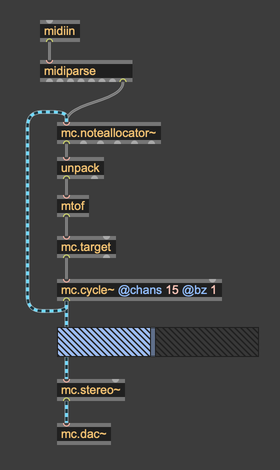
The @usebusymap attribute uses a patcher-global busy map. If you want to control wrapper-based objects in several patchers, or you have more than one mc.noteallocator~ or mc.voiceallocator~ in the same patcher, you can use named busy maps described in the next section.
Using Named Busy Maps
The mc.noteallocator~ and mc.voiceallocator~ objects include a @name attribute that specifies a symbolic name to associate with their internal busy map.
To control DSP resources of a wrapper-based object using a named busy map:
-
Create an mc.noteallocator~ or mc.voiceallocator~ object with a
@nameattribute -
Add the
busymapname(bznamefor short) attribute to each wrapper object you want to control
Here is the mc.noteallocator~ example above using named busy maps:
